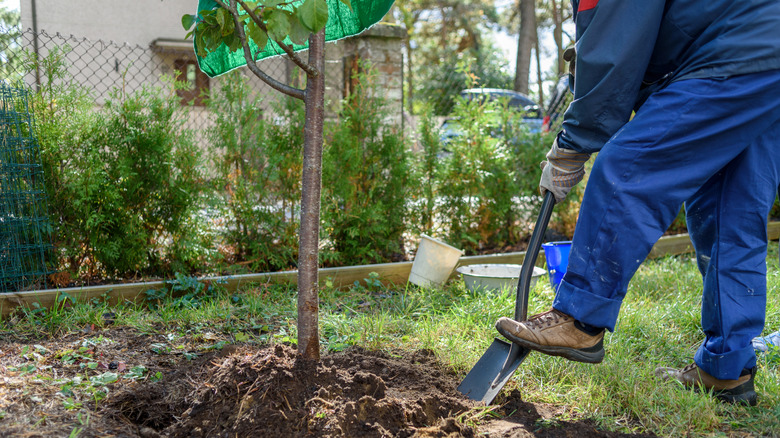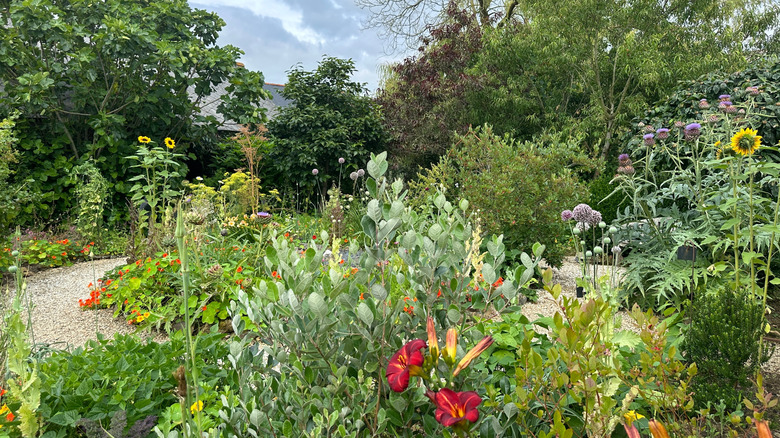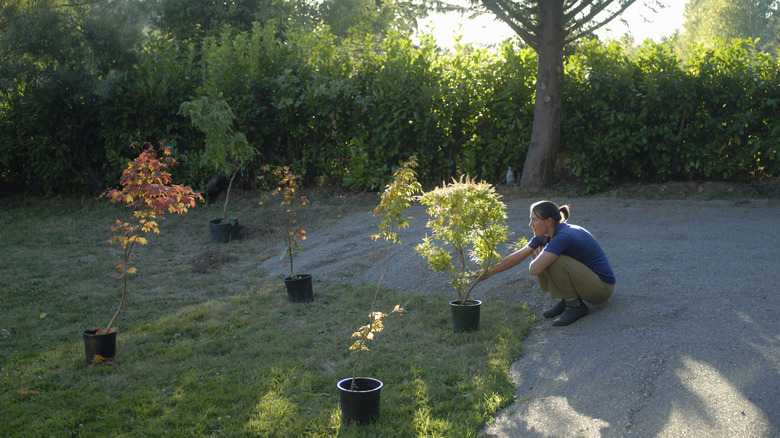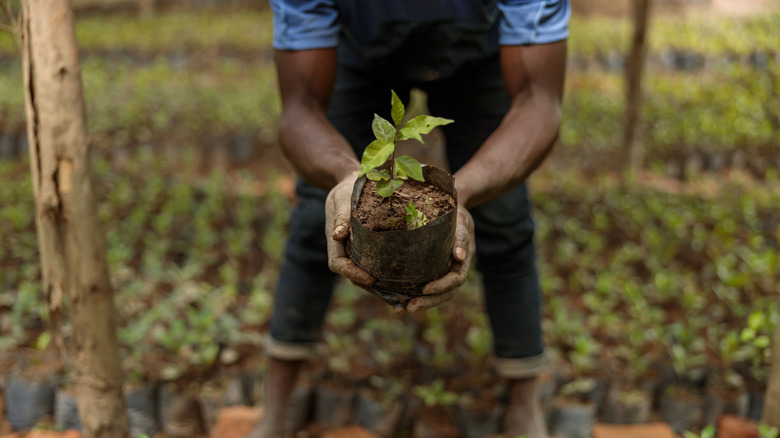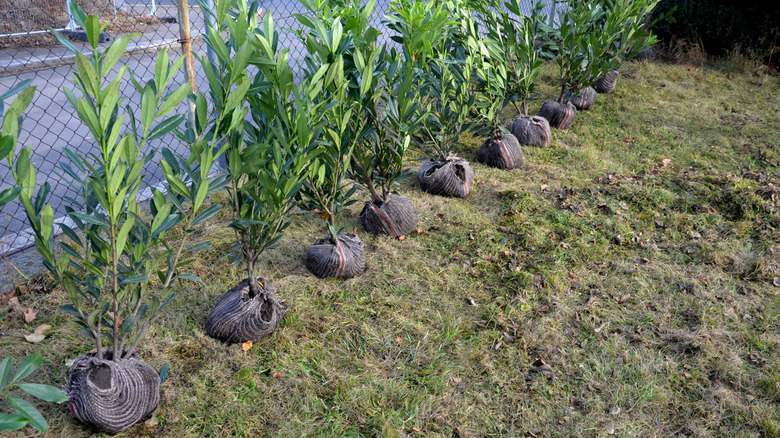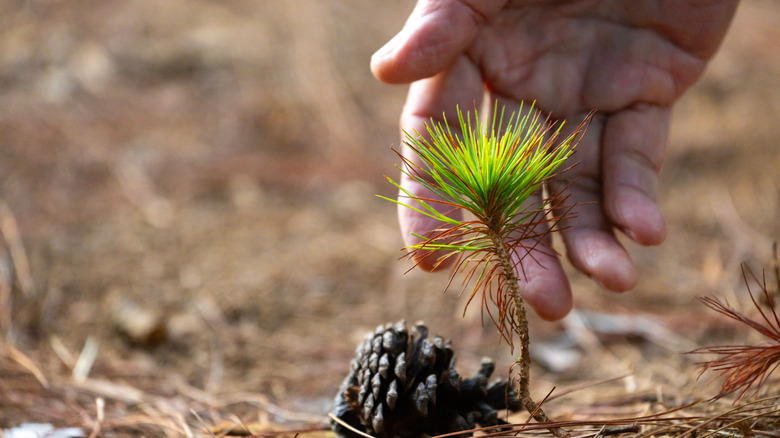Swap Boring Manicured Lawns For One Of The Biggest Backyard Trends Of 2025
One garden trend you'll be seeing more of in 2025 is forest gardening. Instead of a plain carpet of monoculture lawn, some gardeners are transforming their backyards into vibrant, self-sustaining green spaces. Forest gardens are thoughtfully designed landscapes that are meant to mimic a natural forest ecosystem. That means including layers of trees, shrubs, ground cover plants and more to create a tranquil space that both you and the wildlife will love. Specifically, gardeners typically aim to mimic their local environment by including a diverse mix of native species in each layer.
In addition to transforming your backyard into a private natural oasis, this method of gardening is also low maintenance and low cost — at least, in the long run. Depending on what's in your backyard right now, that initial transformation process can take a lot of effort and potentially big investments. However, once everything is established, you will have a curated ecosystem that more or less runs itself.
While you might think you need a massive backyard to hop on this trend, you don't. The method can be applied to even the smallest of yards. If you don't have a yard, you can create a mini-forest garden that fits in a container. The key is to incorporate a diverse mix of species to fill as many of the 7 forest layers as you can fit in the space, and make sure those species like the light and soil conditions you have.
The benefits of transforming your backyard into a forest
There are many reasons to trade your lawn for a forest garden. For gardeners, the self-sustaining forest ecosystem will require little to no maintenance once established. You'll save time and money by not needing to rely on fertilizer, pesticides, or even water. With its dense layers of trees, shrubs, and perennials, the forest aesthetic can also add privacy and a stunning succession of early and late blooms to enjoy all season long.
Some gardeners even create a food forest by prioritizing edible species like blueberry bushes, pecan trees, or patches of wild strawberries that they can harvest fresh produce from each summer. Once established, a food forest can produce harvests year after year without all the work and maintenance that goes into traditional vegetable gardens.
Forest gardens are also great for the environment. By prioritizing native species, you can create valuable habitat for wildlife and beneficial insects. At the same time, the dense vegetation can capture carbon emissions and even reduce air pollution by up to 37%, creating a zone of cleaner air around your home, even if you live in the middle of the city. As your soil health improves and includes more organic matter from your forest garden, it will also be able to store more carbon, further reducing carbon emissions. Healthier soil can also better absorb or break down pollutants, keeping them out of air and water.
Designing a 7-layer forest garden in your backyard
Forests can be roughly divided into 7 layers, ranging from the tallest trees that make the canopy down to the root layer in the soil. While labels vary, the layers are generally divided into the following categories: tall trees or overstory trees, low trees or understory trees, shrubs, annual and perennial herbaceous plants, ground cover, vines or climbers, and roots. That might sound like a lot, but thinking about your garden in terms of layers helps you maximize the space. By choosing species to fill as many of these layers as you can, you might be surprised just how much diversity you can pack into even the smallest of backyards.
When designing your garden, mix plant layers together rather than planting in traditional rows. If possible, position your tallest layer on the north side so that it doesn't completely shade your entire yard. Plants that need shade can be placed closer to these trees while plants that need more light can be planted along the south side.
When sketching your layout, start with the tallest layer and work your way down. Make sure to space your seedlings according to their mature size. When possible, include multiple species in each layer. However, don't over-diversify your flowering plants. Pollinators have an easier time finding their preferred host plants when grown in larger patches. Aim for a minimum of 3 plants of each flowering species. With that in mind, limit the number of species you choose to how many groups of 3 you can fit into your herbaceous plant layer.
How to choose the right mix of plants
The goal of a forest garden is to choose primarily native species to fill in each of the 7 layers. However, not every native will thrive in the exact light and soil conditions in your backyard. It's important to note how much sun different parts of your yard get and inspect your soil's texture and drainage. You can even learn more about the mineral make up and nutrient levels with a soil test. Use this information to find the best native species for your yard.
You'll also need find balance in the design process by creating a forest that fits in your space while including as much diversity as possible. For smaller yards, that might mean just one large tree or skipping that top layer altogether and starting with smaller understory trees or large shrubs. Then, make up for those missing upper layers by adding more variety among the lower layers. If you only have room for one tree, make it an oak. These keystone trees are host to more than 400 butterflies and moths as well as an essential source of food and shelter for birds and mammals. Even in small yards, adding a smaller-sized oak tree like a Chapman oak or scrub oak will have a huge impact.
Finally, consider your personal goals and preferences. Do you want a lot of edible species? Are you more interested in ornamental value and creating a lush, colorful landscape with year-round interest? Maybe you want to prioritize endangered plants native to the U.S. to make your backyard a sanctuary for threatened species.
Tips to transform any backyard into a forest garden
Once you've chosen the right species for your yard, you're almost ready to start planting. Before you put a single seedling in the ground, make sure to remove weeds to reduce the competition your new plants face as they get established. One of the best ways to do this is with sheet mulching. The layers of cardboard, compost, and mulch will smother existing weeds and kill off the weed seed bank in the soil. And it can do so without disturbing the network of beneficial microorganisms living in that soil.
By the time you're ready to plant, you'll also have a thick layer of organic matter to help nourish the seedlings. After planting, plan to spend the first year or two weeding regularly and watering in between rainy periods to ensure your seedlings have little competition and optimal moisture while they're developing their roots.
If your backyard right now is a traditional lawn with no trees to speak of, the task of installing a forest garden might be a little overwhelming. Fortunately, there's no rule that says you have to do it all at once. You can take your time and slowly add layers each season. If you are going to take it slow, it's best to start with the top layer, your trees, since they'll take more time to mature. Then, you can add in plants to fill in the other layers over the years as your time and budget allows.
The challenges of planting a forest garden
The biggest challenge of planting a forest garden is time. Forests aren't born in a day. Even if you have the budget to invest in more mature trees and to plant more plugs and transplants in a single season, it still takes time for your new plants to get established. In the meantime, you'll need to spend time weeding out invasive and weedy species that are competing with your plants. You may also need to periodically add mulch or supplemental water to help newly planted species develop healthy root systems.
Investing that energy now will pay off, though. As your forest garden settles in, it can become a self-sustaining ecosystem that requires little more than harvesting your favorite edibles as they ripen and occasionally trimming back aggressive or unruly growth if you want a more manicured appearance.
To help you stay motivated while you wait for your larger trees and shrubs to mature, plant annuals or ground covers around them to fill in the empty space. These faster-growing species can add color and life to your garden right away. Then as your trees and shrubs grow, you can easily give them room by transplanting or removing these smaller plants.
